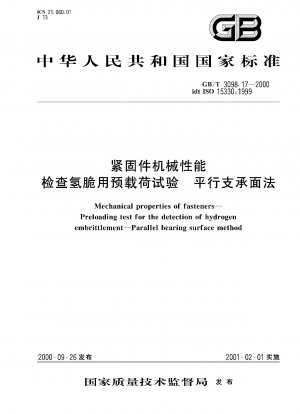GB/T 3098.17-2000
Mechanical Properties of fasteners-Preloading test for the detection of hydrogen embrittlement-Parallel bearing surface method (English Version)
- Standard No.
- GB/T 3098.17-2000
- Language
- Chinese, Available in English version
- Release Date
- 2000
- Published By
- General Administration of Quality Supervision, Inspection and Quarantine of the People‘s Republic of China
- Latest
- GB/T 3098.17-2000
- Scope
- This standard specifies the preload test method for checking the hydrogen embrittlement of fasteners at room temperature. This standard applies to: a) bolts, screws and studs; b) self-extruding screws; c) self-tapping screws; d) self-tapping screws; Drilling self-tapping screws; e) Nuts f) Washers These fasteners are made of steel and are subjected to tensile stress. The temperature range of this experiment is 10-35 degrees. This experiment is only suitable for process control and can be carried out after any manufacturing process, but it is not an item of acceptance test. This experiment enables the evaluation of process state and technical state differences and changes, and determines the different effects of different processes, including pre-plating treatment and post-plating treatment (baking) to reduce free hydrogen in fasteners. Manufacturers and process personnel are not relieved of their responsibility to adopt and monitor process controls because of this experiment.
GB/T 3098.17-2000 history
- 2000 GB/T 3098.17-2000 Mechanical Properties of fasteners-Preloading test for the detection of hydrogen embrittlement-Parallel bearing surface method

GB/T 3098.17-2000 -All Parts
GB/T 3098.1-2010 Mechanical properties of fasteners.Blots, screws and studs
GB/T 3098.10-1993 Mechanical properties of fasteners Bolts, scrows, studs and nuts made of non-ferrous metals
GB/T 3098.11-2002 Mechanical properties of fasteners--Drilling screws with tapping screw thread
GB/T 3098.12-1996 Mechanical properties of fasteners--Cone proof load test on nuts
GB/T 3098.13-1996 Mechanical properties of fasteners--Torsional test and minimum torques for bolts and screws with nominal diameters 1mm to 10mm
GB/T 3098.14-2000 Mechanical properties of fasteners-Widening test on nuts
GB/T 3098.15-2023 Mechanical properties of fasteners—Stainless steel nuts
GB/T 3098.16-2014 Mechanical properties of fasteners.Stainless steel set screws
GB/T 3098.17-2000 Mechanical Properties of fasteners-Preloading test for the detection of hydrogen embrittlement-Parallel bearing surface method
GB/T 3098.18-2004 Mechanical properties of fasteners--Blind rivets testing
GB/T 3098.19-2004 Mechanical properties of fasteners-Blind rivets with break pull mandrel
GB/T 3098.2-2015 Mechanical properties of fasteners.Nuts
GB/T 3098.20-2004 Mechanical properties of fasteners-Wing nuts with specified proof torque
GB/T 3098.21-2014 Mechanical properties of fasteners.Stainless steel tapping screws
GB/T 3098.22-2009 Mechanical properties of fasteners made of the fine grain non-heat treatment steel.Bolts,screws and studs
GB/T 3098.23-2020 Mechanical properties of fasteners—M42~M72 bolts, screws and studs
GB/T 3098.24-2020 Mechanical properties of fasteners—Stainless steel and nickel alloys bolts, screws, studs and nuts for high temperature applications
GB/T 3098.25-2020 Mechanical properties of fasteners—Guidance for the selection of stainless steels and nickel alloys for fasteners
GB/T 3098.26-2021 Mechanical properties of fasteners—Flat washers
GB/T 3098.3-2016 Mechanical properties of fasteners.Set screws
GB/T 3098.4-2000 Mechanical properties of fasteners-Nuts-Fine pitch thread
GB/T 3098.5-2016 Mechanical properties of fasteners.Tapping screws
GB/T 3098.6-2023 Mechanical properties of fasteners—Stainless steel bolts,screws and studs
GB/T 3098.7-2000 Mechanical properties of fasteners-Thread rolling screws
GB/T 3098.8-2010 Mechanical properties of fasteners.Parts for bolted connections for use at temperatures from -200℃~+700℃
GB/T 3098.9-2020 Mechanical properties of fasteners—Prevailing torque type steel nuts